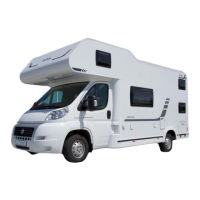03-4
Fig. 2
Fig. 1
2
1
2
3
1
Activation of the stabilization system
• To activate the stabilization system, the
operation lever must be moved downward out
of the closed position
k
until it locks in
l
.
The spring corpus will become tense in the
process, so that contact pressure is created
on the coupling ball via the friction elements.
Afterward, the operation lever lies approxi-
mately parallel to the drawbar axle. Driving
without the stabilization system is possible,
however, and under certain street conditions,
i.e. in ice and snow, advisable.
Inspection of the stabilization system
• After hitching and activating the stabilization
system, the friction lining can be inspected.
The rating plate (type plate) mounted onto the
operation lever (Figure 2-1) indicates a tri-
angular eld marked with +/- signs, parallel to
the slotted hole in the lever which points in
the forward-driving direction. The tension ball
coupler is adjusted on the front side in such
a manner that the cap of a metal pin, visible in
the slotted hole (Fig. 2-2) lies under the "+/-"
signs on the marked side of the triangle.
Shutoff of the stabilization system
• Bring the operation lever slowly upward into
the open position (position
k
) to shut off the
system.
Unhitching
• Pull the operation lever slowly upward into the
open position (position
j
). After releasing the
lighting plug and pull cord, the trailer can be
unhitched from the base vehicle (e.g. with
the help of a drawbar track wheel).
We recommend that you park the trailer with
the tension ball coupler closed if it will not be
used for a signicant period of time. To do
this, lift the opration lever while pulling the ball
socket (movable element with friction lining)
forward and slowly close the service lever.

